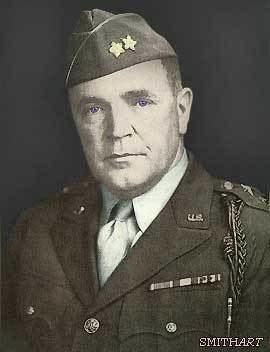Years of service 1918–1955 | Name Paul Kendall | |
 | ||
Born July 17, 1898Baldwin City, Kansas ( 1898-07-17 ) Allegiance United States of America Battles/wars Siberian CampaignWorld War IIKorean War Awards Distinguished Service CrossDistinguished Service Medal (2)Silver Star (3)Legion of MeritBronze Star (2) Commands held | ||
Lieutenant General Paul Wilkins Kendall (July 17, 1898 – October 3, 1983) was a senior United States Army officer, who served during World War I, World War II and Korean War.
Contents
- Early life and military career
- Siberian Campaign
- Post Siberian Campaign
- World War II
- Post World War II
- Korean War
- Post Korean War
- Personal
- Retirement and Death
- Citation for Distinguished Service Cross
- Ribbon bar
- References
Early life and military career
Kendall was born on July 17, 1898 in Baldwin City, Kansas and raised in Sheridan, Wyoming. In 1916, during World War I (although the American entry into World War I did not occur until April 1917) he attained an appointment to the United States Military Academy (USMA) at West Point, New York, from which he graduated in November 1918, receiving his commission as a second lieutenant into the Infantry Branch of the United States Army. By the time he graduated the war had come to an end with the signing of the Armistice with Germany.
Siberian Campaign
Kendall attended the Infantry School of Arms at Fort Benning, Georgia from late 1918 to early 1919.
After completing his training he was assigned to the 27th Infantry Regiment during the Siberian Campaign. Kendall participated in an action on January 10, 1920, for which he received the Distinguished Service Cross.
Post-Siberian Campaign
Kendall carried out a variety of assignments in the 1920s and '30s, including a posting to Fort Logan, Colorado with the 38th Infantry Regiment in 1923 and instructor assignments at the United States Military Academy and Northwestern Military and Naval Academy. Kendall also performed duty in China, Hawaii and the Philippines.
In 1936 Kendall graduated from the Command & General Staff College. In the early 1940s he served in a staff assignment at the Office of the Chief of Staff in Washington, D.C.
World War II
At the start of World War II Kendall was assigned as Chief of Staff of the 85th Infantry Division. He then served as Assistant Division Commander of the 84th Infantry Division, receiving promotion to Brigadier General.
From September 1944 to July 1945 Kendall was commander of the "Blue Devils" of the 88th Infantry Division, receiving promotion to Major General. The division’s second World War II commander, he led it during its assault through Italy, including the capture of Vicenza and Verona.
During the war Kendall received the Silver Star for heroism on three occasions, two in 1944 and one in 1945.
Post World War II
From June 1946 to May 1948 Kendall was commander of the 2nd Infantry Division. He then served as commander of VI Corps at Camp Atterbury, Indiana.
Korean War
In June 1952 Kendall became commander of I Corps, receiving promotion to Lieutenant General. He led the Corps as it manned a defensive line until the end of 1952. In January 1953 the corps took part in an offensive, with troops of the 1st Republic of Korea (ROK) Division attacking the enemy at Big Nori. Beginning in March, the North Koreans and Chinese continually attacked I Corps positions, and I Corps began a phased withdrawal that resulted in numerous enemy casualties. Kendall turned command of I Corps over to Bruce C. Clarke in April 1953.
Post-Korean War
After leaving I Corps Kendall was assigned as Deputy Commanding General, US Army Forces Far East in Manila, Philippines.
In 1954 Kendall was assigned as commander of Allied Land Forces Southeastern Europe in Izmir, Turkey, where he served until his 1955 retirement.
Personal
General Kendall was married to Ruth Child Pistole (November 10, 1900 – January 29, 1985). They had two daughters, Jean and Elizabeth. Jean was the wife of Navy Officer Neal D. Baumgardner and Elizabeth was the wife of Army officer Raymond O. Miller.
Retirement and Death
Kendall retired to Palo Alto, California, where he died on October 3, 1983. He was buried at West Point Cemetery, Section XXVI, Row A, Plot 3.
Citation for Distinguished Service Cross
The official U.S. Army citation for Kendall's Distinguished Service Cross reads:
General Orders: War Department, General Orders No. 35 (1920)Action Date: January 10, 1920Name: Paul Wilkins KendallService: ArmyRank: Second LieutenantRegiment: 27th InfantryDivision: American Expeditionary Forces (Siberia)Citation: The President of the United States of America, authorized by Act of Congress, July 9, 1918, takes pleasure in presenting the Distinguished Service Cross to Second Lieutenant (Infantry) Paul W. Kendall, United States Army, for extraordinary heroism while serving with 27th Infantry, 33d Division, A.E.F. (Siberia), in action at Posolskaya, Siberia, 10 January 1920. Lieutenant Kendall was in command of a detachment of his company when attacked by an armored train at 1 a.m. The detachment under his leadership and inspired by his example attacked and disabled the armored train and caused its surrender.Ribbon bar
Here is his ribbon bar:
